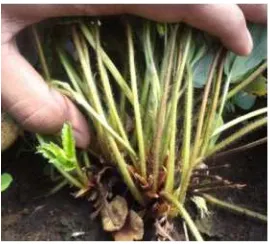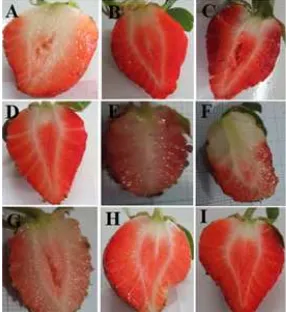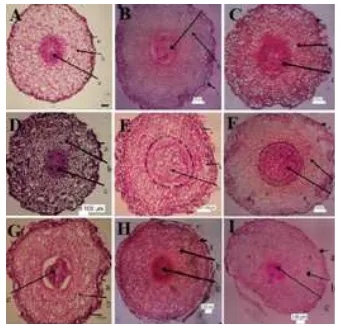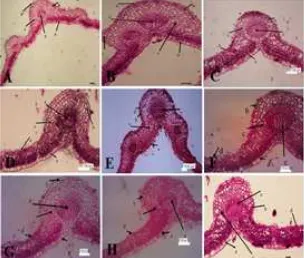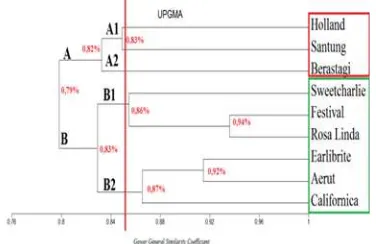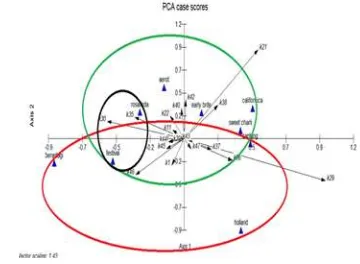INTRODUCTION
Strawberries (Fragaria spp.) are member of the Rosaceae family and native from Europe, which scattered almost all over the world including Indonesia (Santosa, 2011). Strawberry varieties which widely consumed and desired by the peo-ple community is a sweet, brightly colored, and large of strawberry variety. It is an opportunity for the farmers to develop strawberry cultivation techniques and improve the quality and quantity of strawberry production in Indonesia (Hancock, 1999).
The methods for determination of strawberry
phylogenetic relationships is based on morpho-logical and anatomical characters (Mauseth, 1988). The morphological characters of straw-berry plant can be recognized as follows: it has 20-35 primary roots, short-segmented-jointed-her-baceous stem, covered leaves (Hofer et al., 2012). The stem is modified into a crown and has smaller branches called crown branches (Region, 2013). It’s stolon creeps above the ground, the independently growing of which may soon be cut or separated from the parent clump as planting materials (Hummer and Jannick, 2009). The leaf
Phylogenetic Relationships of Nine Cultivars of Strawberries
(Fragaria spp.) Based on Anatomical and Morphological
Characters
DOI: 10.18196/pt.2017.072.116-126
Rina Sri Kasiamdari1*, Ganies Riza Aristya2, Evi Inayati3 1Laboratory of Plant Systematics, Faculty of Biology, Universitas Gadjah Mada,
2Laboratory of Genetics and Breeding, Faculty of Biology, Universitas Gadjah Mada,
3Faculty of Biology, Universitas Gadjah Mada, Jl. Teknika Selatan, Sekip Utara Yogyakarta 55281 Indonesia, Telp. (0274) 580839,
*Corresponding author, email: [email protected]
ABSTRACT
Strawberry cultivation in Indonesia is centred at Citrus and Subtropical Fruit Research Institute, which collect different cultivars of Fragaria spp.
Informa-tion on classiicaInforma-tion based on phenotypic characters of Fragaria spp. has not been studied as a whole. The purpose of the present study was to identify
and determine phylogenic relationships of nine cultivars of strawberries based on the anatomical and morphological characters. The study identiied
morphologically nine strawberry cultivars by referring to the IPGRI (1986). Anatomical preparations of roots, stems and leaves were made by the
embed-ding method. Phylogenetic relationships were determined using MVSP software with UPGMA algorithm through the Gower General Similarity Coeficient
method. Subsequently, the principal components were analyzed using the Euclidian Biplots algorithm depicted in a Scatter plot. The phylogenetic relationship produced two clusters with 79% similarity index. The closely related cultivars were Festival and Rosa Linda with a similarity index of 94%, and Earlibrite and Aerut with a similarity index of 86%.
Keywords: Fragaria spp., Anatomical, Morphological, Phylogenetic relationships
ABSTRAK
Balai Penelitian Jeruk dan Tanaman Sub-tropika merukan pusat budidaya stroberi yang ada di Indonesia. Informasi klasiikasi berdasarkan karakter fenotip
Fragaria spp. belum dipelajari secara keseluruhan. Penelitian ini bertujuan untuk mengetahui klasiikasi dan hubungan kekerabatan beberapa kultivar stro
-beri berdasarkan karakter Anatomis dan Morfologis. Dalam penelitian ini dilakukan klasiikasi beberapa kultivar stro-beri yang mengacu pada IPGRI (1986)
dan UPOV (2012). Pembuatan preparat anatomis akar, batang dan daun dilakukan dengan metode penyelubungan (embedding). Hubungan kekerabatan
ditentukan dengan menggunakan software MVSP dengan algoritma UPGMA melalui metode Gower General Similarity Coeficient. Selanjutnya dilakukan
analisis komponen utama menggunakan algoritma Euclidian Biplots yang digambarkan dalam bentuk Scatter plot. Hasil penelitian dari sembilan kultivar
yang diamati menunjukkan kultivar yang berkerabat dekat adalah Festival dan Rosa Linda pada indeks similaritas 94% dan kultivar Earlibrite dan Aerut dengan indeks similaritas 86 %.
is green, trifoliate and serrated, the entire surface of which is covered by trichomes (Region, 2013). The flowers are hermaphrodite, consists of 5-10 sepals, five crown petals, 20-35 stamens arranged in panicles. Each branching panicle has four types of flowers: one primary or terminal flower, the earliest blooming one; two secondary flow-ers; four tertiary flowflow-ers; and eight quaternary flowers (Region, 2013). False fruits come out of the enlarged receptacle, is conical to round in shape and stick to the base of the flower (Hum-mer & Jannick, 2009). Bright to dark red fruits of ±2.5-5 cm in size are aggregate fruits composed of several achenes (Budiman and Saraswati, 2005). Seeds are small occurring within the fruit flesh (Rukmana, 1998).
In a cross section, the structure of strawberry root and stem from the outside to the inside includes the epidermis and cortex, consisting of intercellular spaces with the outermost layer ad-jacent to the epidermis called the exodermis, ca-pable of differentiation into hypodermis (Murti
et al., 2012). The innermost layer of the cortex is
composed of the endodermis capable of phellem thickening on the walls and forming dots called the Casparian dots resembling U-like shape. The innermost layer, stele, with is the outermost layer of the stele directly adjacent to the endodermis, is referred to as the pericycle. In addition to the pericycle, there is also the medulla as the innermost layer consisting of the parenchymal tissue. Medulla is surrounded by vascular tissues, consists of the xylem and phloem arranged alter-nately in the direction of the radius (Esau, 1977).
The anatomical structure of strawberry leaf generally includes the epidermis serving as pre-venting water loss from transpiration, regulating gas exchange, secreting metabolic compounds, and (in some species) absorbing water (Naseri and Tantawy, 2003). This layer occurs in two sec-tions, on the surface facing upward (adaxial) and
on the surface facing downward (abaxial). The mesophyll is composed of homogeneous paren-chyma cells and differentiates into mass tissues or palisade parenchyma, as well as the vascular tissues consisting of xylem and phloem (Esau, 1977).
Variations in the strawberry plant are among the advantages of the plant, making it possible to create plant hybrids affected by the close phyloge-netic relationships of several phenotypic appear-ances (Nielsen and Lovell, 2000). The higher the phenotypic similarity the closer the phylogenetic relationship is (Esau, 1977). The purpose of the present study was to determine the anatomical and morphological characters of nine cultivars of strawberries and to determine the phylogenetic relationships of nine cultivars of strawberries based on anatomical and morphological obser-vation, as well as the specific characters of an important effect on the grouping of the nine cultivars of strawberries (Chandler et al., 2000).
MATERIALS AND METHODS Collection of Strawberry Samples
Nine cultivars of strawberries were taken from Indonesian Citrus and Subtropical Fruit Research Institute, Malang, East Java. Each strawberry plant was subjected to data collection of the morphological characters of roots, stems, leaves, flowers and fruits with reference to the IPGRI (The International Plant Genetic Re-sources Institute) (1986), UPOV (International Union for the Protection of New Varieties of Plants) (2012) and Hofer et al. (2012) with some additional modifications.
Making of Anatomical Preparations Sample Cutting
by transversely cutting leaves through the midrib. The collected samples of roots, stems and leaves were stored in flakon bottles containing 70% al-cohol and labeled in accordance with the cultivar name.
Embedding Method
Samples were fixed using FAA
(formaldehyde:glacial acetic acid:alcohol) solu-tion with a ratio of 90ml:5ml:5ml, respectively, and allowed to stand for 24 h. It was then
washed with 70% alcohol for 30 min and stained with 1% safranin in 70% alcohol for 24 h. Sam-ples were dehydrated in a graded alcohol series (70%; 80%; 95%; 100%, 100%) and dealcohol-ized in a graded ratio of alcohol:xylol (v3:1; v1:1; v1:3; xylol; xylol). Subsequently, it was subjected to infiltration by removing the xylol:paraffin mixture and replacing it with pure paraffin at a temperature of 57°C for 24 h (Sutikno, 2014). Paraffin was replaced with new pure paraffin for one hour and samples were made into blocks. Samples were cut using a rotary microtome to make slices of 6-12 micrometer in thickness. The slices were fixed on an object glass with a glycerine:albumin mixture added with water and placed on a hot plate at a temperature of 45C. The slices were stained with 1% safranin in 70% alcohol and placed in a graded mixture of alcohol: xylol (3:1; 1:1; 1:3; xylol; xylol). It was covered with a glass lid with Canada Balsam and dried. The samples were labeled and annotated with the name of the species, organ, cross-section and date.
Data analysis
Descriptive analysis was performed by describ-ing and identifydescrib-ing the vegetative and generative organs of the specimens through recording the morphological traits and characteristics. Numeri-cal analysis was carried out by comparing the
anatomical and morphological data and phylo-genetic relationships were identified by means of cluster analysis.
RESULTS AND DISCUSSIONS
Based on the inventory of strawberries at the Citrus and Subtropical Fruit Research Institute, there were nine cultivars of strawberries which could be identified from the two Fragaria species, namely Fragaria vesca of Californica subspecies, and eight strawberry cultivars of F. anannassa
Duchesne including Rosa Linda, Berastagi, Festi-val, Santung, Holland, Sweet Charlie, Aerut, and Earlibrite.
Morphology
in-cluding, among others, type of growth, leaf size, shape of leaf edges, shape of the leaf base, type of flower attachment, petal size relative to the crown, petal attachment to fruit, petal direction towards fruit, fruit shape, external color of the fruit and core color (Ryall and Lipton, 1972).
Morphological characters of the stem ob-served were the type of growth, the number of stems in a plant, robustness of the plant, ability to generate stolons, timing of stolon emergence and direction of hair growth on the stem (Fig-ure 1).
The nine cultivars had a moderate number of stems in a plant (>3 stems/plant), a moder-ate ability to genermoder-ate stolon (>10 stolon/plant), a quite fast emergence of stolon, a horizontal growth direction of hairs on the stolon and high robustness of the plant. The character of plant robustness was influenced by the anatomi-cal structure of the stem. This is due to the fact that strawberries are a dicotyledonous plant whose stems are subjected to secondary growth by having a lateral meristem. Additionally, the clustering life form of strawberries also supports the robustness of their stems.
Figure 2 showed a low degree of variations in the types of growth. Those variations in the types of growth included upright, intermediate and spreading referring to the UPOV (2012). The cultivars of strawberries with upright growth were Californica and Aerut, while those with interme-diate growth were Rosa Linda, Berastagi, Festival, Santung, Holland, Sweet Charlie, and Earlibrite.
Figure 3 showed that those cultivars with rounded leaf base are Californica, Rosa Linda, Berastagi, Festival, Santung, Holland and Aerut. Those cultivars with obtuse leaf base were Sweet Charlie and Earlibrite with medium green leaves and varying sizes from small (5-10 cm) to medi-um (10-15 cm). Those cultivars with a small-sized leaves wereRosa Linda and Holland. Cultivars
with medium-sized leaves were Californica, Be-rastagi, Festival, Santung, Sweet Charlie, Aerut and Earlibrite.
Figure 1. Stems of strawberry plants
Figure 2. Types of growth of nine cultivars of strawberries. (A) Californica, (B) Rosa Linda, (C) Berastagi, (D) Festival, (E) Santung, (F) Holland, (G) Sweet Charlie, (H) Aerut, (I) Earlibrite. (Upright: A and
H; Intermediate: B-G and I)
Figure 3. The shape of leaf base of nine cultivars strawberries; (A) Californica, (B) Rosa Linda, (C) Berastagi, (D) Festival, (E) Santung, (F) Holland, (G) Sweet Charlie, (H) Aerut, (I) Earlibrite. (Obtuse: G and I;
Figure 4 showed that the cultivar with ser-rated leaf edge was Holland; cultivars with in-termediate leaf edge were Californica, Berastagi, Festival, Santung, Sweet Charlie, Aerut and Earlibrite; the cultivar with crenate leaf edge was Rosa Linda.
Figure 4. Shape of leaf edges of nine cultivars of strawberries; (A) Californica, (B) Rosa Linda, (C) Berastagi, (D) Festival, (E) Santung, (F) Holland, (G)
Sweet Charlie, (H) Aerut, (I) Earlibrite. (Serrate: F;, Crenate: B; Intermediate: A, C-E, G-I)
Figure 5. Types of attachment of crown; (free: B, D, F, Stacked: A, C, E, G-I) and size of petal relative to the
crown (smaller: G; equal: B, D, F; bigger: A, C, E, G-I) of nine cultivars of strawberries, (A) Californica, (B) Rosa Linda, (C) Berastagi, (D) Festival, (E) Santung, (F)
Holland, (G) Sweet Charlie, (H) Aerut and (I) Earlibrite
Observations on morphological characters of flowers and fruit of the nine cultivars showed that those cultivars had moderate number of flowers in a plant, flowers located below the leaves, good strength of receptacle on the bud,
hermaphrodite flowers, medium-sized fruits (3 cm), bright red fruit flesh, moderate achene den-sity, high robustness of fruits. These characters were not affected by the anatomical structure of the constituent fruits and stems.
Figure 5 showed that those cultivars with free attachment of flowers were Berastagi, Festival and Holland. Those cultivars with stacked crown are Californica, Rosa Linda, Santung, Sweet Charlie, Aerut and Earlibrite. The strawberry cultivar with petals smaller than the crown was Sweet Charlie, and those cultivars with petals equal to the crown were Rosa Linda, Festival and Holland. Cultivars with larger petals than the crown are Californica, Berastagi, Santung, Aerut and Earlibrite.
Figure 6. Core colors (white: A, F, G; bright red: B-E, H-I) and types of calyx attachment to the fruit (recessed:
C; lat: A, B, D-E, G-I; protruded: F) of nine cultivars
of strawberries; (A) Californica, (B) Rosa Linda, (C) Berastagi, (D) Festival, (E) Santung, (F) Holland, (G)
Sweet Charlie, (H) Aerut and (I) Earlibrite
Observations of the fruit shapes of the nine cultivars studied showed variations that could be divided into four groups: ovoid, conical, cylindri-cal and cordate. Cultivars with ovoid fruits were Californica, Santung and Holland. Cultivars with conical fruits were Rosa Linda, Berastagi and Festival. The cultivar with cylindrical fruits was Sweet Charlie and cultivars with cordate fruits were Aerut and Earlibrite (Figure 7).
Figure 7. Fruit shapes (ovoid: A, E, F; cylindrical: G; conical: R, B, F; cordate: H, I) and growth direction
of petals relative to the fruit (upward: C-A; lat: D-I)
of nine cultivars of strawberries, (A) Californica, (B) Rosa Linda, (C) Berastagi, (D) Festival, (E) Santung, (F)
Holland, (G) Sweet Charlie, (H) Aerut and (I) Earlibrite
Anatomy
The present study observed anatomical char-acters of roots, stems and leaves. Strawberries are dicotyledonous plants with roots composed of epidermis, cortex and stele. Root epidermis con-sists of a layer of cells and contains no cuticle. In the epidermis a layer of root fibrous cells is found that is developed from the epidermal cells in region of apical meristem (Figure 8). Its func-tions are to absorb nutrients and hold the roots in the ground.
Table 1 showed that the cultivar with the largest diameter of root is Californica (1501.31
m) and that with the smallest diameter of root is Berastagi (774.73 µm). Calculation of the size of the cortical cells also showed similar results, with the largest cortical cell being Californica (58.64
µm) and the smallest being Festival (30.29 µm). Diameter of the root and size of cortical cells is closely related to metabolic processes affecting nutrient absorption and translocation of pho-tosynthetic products. The larger the size of the cortical cells, the greater the diameter of the root is.
Figure 8. Cross-sections of the roots of Fragaria spp. of cultivars (A) Californica, (B) Rosa Linda, (C) Berastagi,
(D) Festival, (E) Santung, (F) Holland, (G) Sweet Charlie, (H) Aerut and (I) Earlibrite with constituent tissues of (a) epidermis, (b) cortices and (c) stele. Bar scale: 100
μm
Table 1. Mean Anatomical Structure of Roots of Nine Strawberry Cultivars
Character Cultivar Root Diameter Size of Cortical Cells
Californica 1501.31 ± 115.57 a 58.64 ± 5.99 a
Rosa Linda 884.66 ± 37.75 def 36.21 ± 8.04 cd
Berastagi 774.73 ± 70. 67 f 39.20 ± 8.95 bcd
Festival 771.95 ± 75. 89 f 30.29 ± 12.59 d
Santung 983.66 ± 41.10 bcde 37.51 ± 5.19 cd
Holland 996.61 ± 151.64 bcd 55.31 ± 27.77 ab
Sweet Charlie 861.13 ± 82.11 ef 30.92 ± 5.35 d
Aerut 1109.51 ± 154.29 bc 52.45 ± 5.99 abc
Earlibrite 1124.67 ± 85.13 b 51.51 ± 5.08 abc
Observations were also performed on the strawberry stem composed of epidermis, cortex and stele, which consists of the vascular tissues and medulla (Figure 9).
Figure 9. Cross-section of the stems of Fragaria spp. of cultivars (A) Californica, (B) Rosa Linda, (C) Berastagi,
(D) Festival, (E) Santung, (F) Holland, (G) Sweet Charlie, (H) Aerut and (I) Earlibrite with constituent tissues of (a) epidermis, (b) cortex and (c) the stele. Bar scale bar:
100 μm
Table 2. Mean Anatomical Structure of Stems of Nine Strawberry Cultivars
Character Cultivar Stem Diameter Size of Cortical
Cells Size of Stele Cells
Californica 3001.15 ± 170.29 b 89.69 ± 15.03 a 66.26 ± 10.19 ab
Rosa Linda 2298.28 ± 267.16 c 77.82 ± 11.35 cd 63.58 ± 10.24 bc
Berastagi 1478.67 ± 121.96 d 54.45 ± 18.43 bcd 40.97 ± 18.16 d
Festival 3439.56 ± 329.25 a 95.69 ± 21.52 d 68.04 ± 19.87 ab
Santung 2054.79 ±143.42 e 59.46 ± 10.69 bcd 39.52 ± 7.98 cd
Holland 2014.18 ± 264. 59 e 67.91 ± 12.89 ab 47.95 ± 14.12 cd
Sweet Charlie 2451.84 ± 56.65 e 102.23 ± 7.6 d 89.14 ± 3.74 a
Aerut 2538.05 ± 101.16 e 92.09 ± 13.41 abc 73.75 ± 10.58 ab
Earlibrite 2107.72 ± 60.71 e 99.38 ± 18.71 abc 88.17 ± 16.72 a
Note: Numbers followed by the same letter in a column indicate no significant difference in DMRT test at a significant level of 0.05%. (Bold number: cultivar with the highest thickness; underlined column; cultivars with the lowest thickness).
Table 2 showed a significant difference in which cultivars with moderate diameter of stem being Berastagi, Festival, Holland and Earlibrite while others with a large diameter of roots. The cultivar with the largest diameter of stem wasFes-tival (3439.56 µm), while the smallest one was Berastagi (1478.67 µm). The same results were
also shown by the measurement of cortical cells in which Berastagi cultivar had a large size of cortical cells (99.38 µm). This may occured due to the fact that the number of cells making up the cortex of Earlibrite cultivar was smaller than that of other cultivars; thus, despite the moder-ate size of cortical cells, it had the same diameter as other cultivars. The larger the size of the cells making up the stem, the larger diameter of the stem is.
Observations of the leaves of strawberry plants showed that it was composed of me-sophyll, upper epidermis, lower epidermis, hypodermis and vascular tissues. Mesophyll was flanked by adaxial and abaxial epidermis, composed of palisade parenchyma and spongy parenchyma. The section was dominated by chlorenchyme, the chlorophyll-containing paren-chyma (Figure 10).
Figure 10. Cross-section of the leaves of Fragaria spp. of cultivars (A) Californica, (B) Rosa Linda, (C) Berastagi, (D) Festival, (E) Santung, (F) Holland, (G) Sweet Charlie, (H) Aerut and (I) Earlibrite, with constituent tissues of (a) upper epidermis, (b) hypodermis, (c) mesophyll, (d) lower epidermis and (c) vascular tissues. Bar scale: 100
μm
culti-var with the thinnest lower epidermis is Santung (14.76 m). Measurement of epidermal thickness showed a low variation, in which the cultivar with the thickest upper epidermis was Holland (16.45 µm), and the cultivar with the thinnest upper epidermis was Berastagi (10.41 µm). Mea-surement of the thickness of the vascular tissues also showed that the cultivar with the thickest vascular tissues was Holland (235.96 µm), and the cultivar with the thinnest vascular tissues was Earlibrite (165.52 µm).
Measurement of hypodermal thickness showed that the cultivar with the thickest hypo-derm was Rosa Linda (32.99 m) and the culti-var with the thinnest hypoderm was Santung. Hypodermis is the tissue occurring between the mesophyll and epidermis and has no chlorophyll.
Results of the present study indicated that all nine cultivars of strawberries showed significant variations in the anatomical characters even with-in the same species. The variations are thought to be due to environmental influences, such as temperature, altitude, humidity, soil type and soil conditions. Murti et al. (2012) stated that phenotypic appearances could be controlled by the genetic properties of the plant itself, which are the responses to the interaction with envi-ronmental factors. This was due to the effects
of domestication of strawberry plants, which are originally commonly grown in a sub-tropical climate but grown in Indonesia with a tropical climate and different environmental factors. For example, different light intensities produce plants with different characters, where high light intensities generate high photosynthetic prod-ucts, thus leading to changes, such as changes in the anatomical structure with thicker mesophyll tissue for translocation of photosynthetic prod-ucts, thus the leaves becoming thicker and the number of trichomes found on the upper sur-face of the leaf becoming fewer and even absent (Rofhl, 1992).
Phylogenetic Relationships
The present study analyzed the phylogenetic relationsships among nine strawberry cultivars using the cluster analysis method. An analysis of principal components was carried out to determine the role of each cluster in the group-ing of cultivars. The 47 characters were scored using the method of Multi-State Characters. The dendogram of cluster analysis was gener-ated by calculating the Gower General Similarity Coefficient and the UPGMA (Unweighted Pair Group Method with Arithmetic Mean) clustering technique.
Table 3. Anatomical Structure of Leaves of Nine Strawberry Cultivars
Character Cultivar Mesophyll Thickness Epidermal Thickness Vascular Tissue Thickness Lower Epidermal Thickness Hypodermal Thickness
Californica 244.70 ± 40. 47 b 14.16 ± 5.31 ab 127.39 ± 15.00 c 32.29 ± 8.31 bcd 22.91± 9.54 ab
Rosa Linda 269.90 ± 33.59 b 21.41 ± 8.80 a 169.83 ± 45.99 bc 42.49 ± 9.66 ab 32.99 ± 13.78 a
Berastagi 257.29 ± 59 b 10.41 ± 2.47 b 177.61 ± 29.77 b 37.55 ± 7.29 abc 17.39 ± 4.48 b
Festival 356.57 ± 67.46 a 15.35 ± 4.51 ab 203.48 ± 39.3 ab 36.37 ± 7.68 abc 24.71 ± 8.47 ab
Santung 320.72 ± 32.99 ab 10.85 ± 4.09 b 184.34 ± 13.15 b 23.55 ± 12.26 d 14.76 ± 4.79 b
Holland 307.31 ± 28.24 ab 16.45 ± 4.59 ab 235.96 ± 21.06 a 48.07 ± 7.33 a 23.83± 6.90 ab
Sweet Charlie 251.71 ± 21.00 b 13.45± 2.48 ab 179.66 ± 16.22 b 31.57 ± 4.21 bcd 21.45 ± 4.05 ab
Aerut 241.82 ± 27 b 14.38 ± 5.8 ab 168.95 ± 14.6 bc 29.01 ± 6.87 cd 19.89 ± 5 b
Earlibrite 250.39 ± 40.32 b 16.00 ± 3.41 ab 165.52 ± 15.21 bc 31.15 ± 3.76 bcd 22.29 ± 3.60 ab
Figure 11. Dendogram of phylogenetic relationships of nine cultivars of strawberries
Dendogram showed that there are two main types, cluster A and cluster B (Figure 11). Clus-ter A diverged into two clusClus-ters, A1 consists of cultivars Santung and Holland and cluster A2 consists of cultivar Berastagi; those clusters con-verge at a distance of 84%. Cluster B concon-verges at a distance of 83%, diverged into two clusters, B1 consists of Festival, Rosa Linda, Sweet Char-lie, and B2 consists of Earlibrite, Aerut and Californica. Combination of characters that determine the formation of the two clusters A and B are the fruit shape, external color of the fruit, attachment of the flower, size of the petals and thickness of the hypodermal cells. Cluster A has ovoid-conic fruits, moderately bright fruits and freely attached flowers. Cluster B has ovoid-cylindrical fruits with moderately bright fruits and dominantly stacked attachment of the flow-ers. According to Singh (1999), members of each cluster will converge into a specific cluster based on the score of similarity index of the member of the cluster; the higher the score of the similarity index, the more closely related it is. Dendogram indicated that Holland and Santung cluster on a degree of similarity of 85%, while Berastagi diverged from those two cultivars at a degree of similarity of 84% of combination of the same characters, so that the three groups cluster be-longs to one cluster. Those three cultivars have
an intermediate type of growth and rounded leaf base. Combination of characters that diverged Berastagi from two cultivars (Holland and San-tung) were attachment direction of petals, fruit shape and core color. Holland and Santung had moderate attachment direction of petals, ovoid fruits and white core, while Berastagi had an upward attachment direction of petals, conical fruits and pink core. Combination of the same characters that clusters Sweet Charlie, Festival, Rosalinda, Earlibrite, Aerut and Californica cre-nate leaf edges, equal attachment of the petals to the fruit, and bright red core on the fruit.
Additionally, dendogram also showed Festival at the same clusters with Rosa Linda with the highest index of similarity of 94%, but they were not clustered with Earlibrite, all of which having the elder Rosa Linda; however, both cultivars clustered with Earlibrite into cluster B with a similarity index of 83%. Chandler (2000) argued that ‘Earlibrite’ is a cultivar originating from a crossbreeding between Rosa Linda and FL 90-38 in a study conducted in Florida, while Festival is a crossbreeding between Rosa Linda and ‘Oso Grande’. The characters diverging Festival, Rosa Linda and Earlibrite are the fruit shapes, size of the petals, stem diameter and thickness of the lower epidermis. On the other hand, Sweet Charlieat the same clusters with Rosa Linda and Festival at a degree of similarity of 85%. Dendo-gram also indicated that Earlibrite more closely clustered with Aerut at a similarity index of 87%.
In this study, besides using cluster analysis, the nine strawberry cultivars were also analyzed by the ordination technique (Principle Com-ponent Analysis) to determine the role of each character. In the present study the character con-sidered as influential is the character with Eigen
value of ≥ 0.2. Results of the principal compo
charac-ters that distinguish the nine strawberry culti-vars. Those characters were the type of growth, growth density, fruit shape, external color of the fruit, attachment of a crown to the flowers, size of the petals, core color, location of attachment of the calyx to the fruit, root diameter, size of the cortical cells of the root, stem diameter, size of the cortical cells of the stem, size of the stele cells of the stem, thickness of the upper epidermis, thickness of the lower epidermis and thickness of the hypodermis. The 16 characters converged to form a combination that distinguished nine strawberry cultivars.
The combination of clusters on the dendo-gram based on anatomical and morphological characters supported phylogenetic relationships as indicated on the dendogram. Clustering of anatomical and morphological characters largely followed the pattern of divergence of varieties. In the hierarchy of classification, the higher the degree of similarity related with the closer the phylogenetic relationship. A taxon is considered
to be a genus when it has a similarity index of ≥ 65% and ≥85 for the species (Singh, 1999).
Results of cluster analysis showed that varia-tions in characters among strawberry cultivars based on morphological characters are higher than that based on anatomical characters. It may occur due to environmental influences that lead to the morphological variations of strawberry cultivars.
Figure 12 is formed from the Eigen values of characters in a vector form. Notes to characters in the diagram are shown in Appendix 1. Calcu-lation results of the distribution of nine cultivars of strawberries showed that cluster A (Holland, Berastagi, Santung) diverged from cluster B (Californica, Rosa Linda, Festival, Sweet Char-lie, Aerut and Earlibrite), caused by fruit shape, external color of the fruit, attachment of the
flower, size of the petals and thickness of the up-per epidermal cells. The characters distinguish-ing the nine cultivars observed were the type of growth and fruit shape.
Figure 12. Distribution of nine cultivars of strawberries based on anatomical and morphological
analysis
Genetic variations may occur due to several evolutionary forces, such as migration, mutation and genetic drift. In Hummer (2009) argued that migration occurs when individuals of a population move to other populations and there is interbreeding with individuals in the receiv-ing population. Thus, strawberry plants that are native to Europe with the sub-tropical habitat are subject to phenotypic changes, such as the fruit shape as a form of adaptation, when planted in Indonesia.
Table 4. Distance matrix of cluster analysis based on anatomical and morphological characters
A B C D E F G H I
A 1.000
B 0.805 1.000
C 0.738 0.787 1.000
D 0.784 0.936 0.809 1.000
E 0.83 0.763 0.823 0.784 1.000
F 0.764 0.8 0.842 0.864 0.849 1.000
G 0.809 0.844 0.759 0.865 0.851 0.76 1.000
H 0.865 0.812 0.787 0.833 0.823 0.757 0.844 1.000
I 0.865 0.855 0.787 0.876 0.865 0.842 0.844 0.915 1.000
CONCLUSION
There were 37 anatomical and morphological characters that play a role in the characterization of nine cultivars (25 synthetic characters and 12 diagnostics characters). Earlibrite and Aerut were closely related cultivars with a similarity index of 86%, and so did Festival and Rosa Linda with a similarity index of 94%. Of the 47 characters, shape of the fruit and type of attachment of the flowers were the main characters distinguishing among the nine cultivars studied.
REFERENCES
Budiman, S., dan D., Saraswati. 2005. Berkebun Stroberi Secara Komersial. Penebar Swadaya: Jakarta.17-23 p.
Chandler, C.K., Legard. D.E., Dunigan, D.D., Crocker, T.E., Sims, C.A. 2000. Earlibrite Strawberry. Digital Commons. University of Nebraska-Lincoln
Esau, K. 1977. Anatomy of Seed Plants. John Wiley and sons. New York. 129-131 pp.
Hancock, J.F. 1999. Strawberries. Crop Production Science in Holticulture. CABI Publishing. USA.
Hofer, Monika, R. Drewes-Alwarez, P. Scheewe & K. Olbricht. 2012. Morphological evaluation of 108 strawberry culti-vars- and consequences for the use of descriptors. Journal of Berry Research 2: 191-206.
Hummer, K. E & J. Jannick. 2009. Rosaceae: taxonomy, Economic Importance, Genomic. Springer. UK.
IBPGR. 1986. Strawberry descriptors (Fragaria L.) International Board for Plant genetic resources. Rome.
Mauseth, J.D. 1988. Plant Anatomy. The Benjamin Cummings Publishing Company, Inc. California. USA. 34 p.
Murti, R.H., H.Y. Kim and Y.R. Yeoung, 2012. Morphological and anatomiscal characters of ploidy mutants of strawberry. Int. J. Agric. Biol. 14: 204–210.
Naseri, M.M., Tantawy, M.E. 2003/ A Contribution to the Achene Knowledge of Rosoidae (Rosaceae) LM and SEM: Interna-tional Journal of Agriculture & Biology 5(2):-.
Nielsen JA, Lovell PH (2000). Value of morphological characters
for cultivar identiication in strawberry (Fragaria ananassa):
New Zealand Journal of Crop and Horticultural Science
28:89–96.
Region, N. 2013. The Mid-Atlantic Berry Guide. Penn State Coop-erative Extension. Atlantic. 49-50 pp.
Rohlf, J.F. 1992. Numerical Taxonomy and Multivariate Analysis System.Version 1.70. NTSYS-pc Manual Book, Applied Biosta-tistics. NewYork.
Rukmana, R. 1998. Stroberi, Budidaya dan Pascapanen. Kanisus: Yogyakarta.
Ryall M. and Lipton. 1972. Tomatoes commodity requirements of ryie fruits handling. Transportation and storage of fruit and vegetables. West point Connecticut. The AVI Publ. Con. Inc. Santosa, A.A. 2011. Pengelolaan Pembibitan Stroberi Di Vin’s
Berry Park, Cisarua, Bandung Barat, Jawa Barat. Naskah Skripsi. Fakultas Pertanian. Institut Pertanian Bogor. Bogor. 6p.
Simon, I., E. Racz and J.M. Zatyko, 1987. Preliminary notes on somaclonal variation of strawberry. Fruit Sci. 14: 154–155. Singh, G. 1999. Plants Systematics. Science Publisher. New York.
561 p.
Sutikno. 2014. Petunjuk Praktikum Mikroteknik Tumbuhan.
Fakultas Biologi UGM. Yogyakarta.
